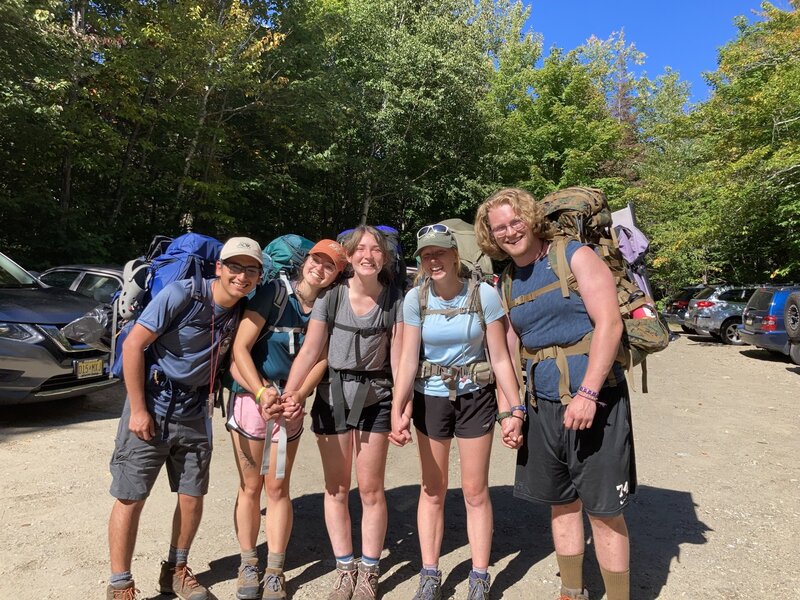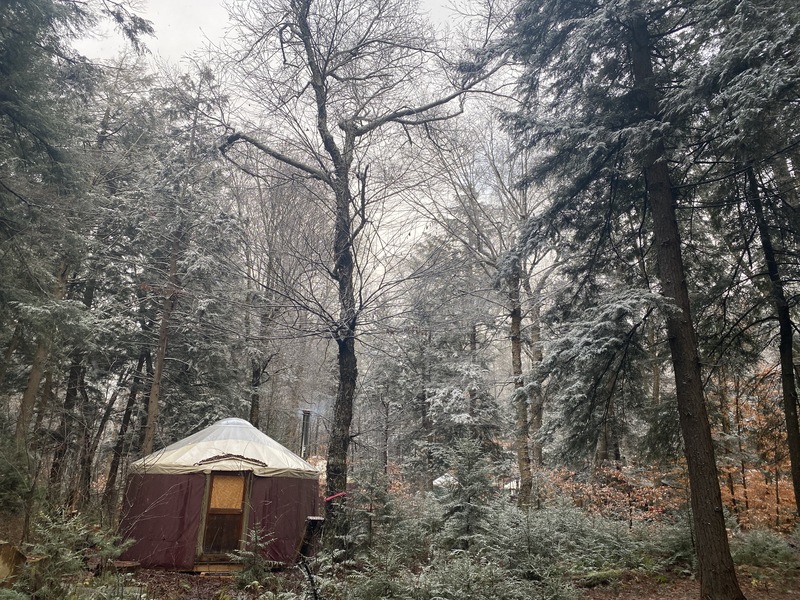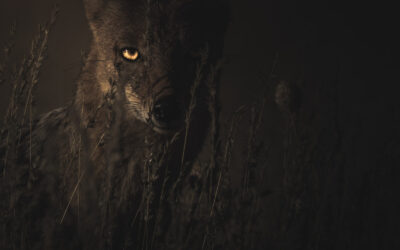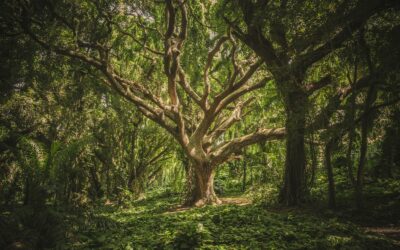Adirondack Mountains during fall. Photo by Hazal Ozturk on Unsplash
Solitude and Spiritual Importance in an Era of Isolation
Communication & Education
April 2022 | Volume 28, Number 1
Towards the end of February of 2020, I spoke at a public forum in Keene Valley, New York. The small rural community serves as a gateway to the High Peaks Wilderness of the Adirondack Park, and having been asked by a local citizens committee, I presented research on the topic of visitor use management. Like many protected areas, the Adirondacks perennially wrestle with the paradox of how to provide access to public land without unacceptably degrading the very resources visitors are there to enjoy. My brief talk included case studies of how national parks across the United States have, and continue to, address these issues through legislative guidance, relevant environmental policy, and sound science.
Following my presentation, a civil dialogue among the audience ensued. Community members shared perspectives on issues of parking, trail degradation, search and rescue efforts, rock climbing opportunities, and especially the value of wilderness experiences. The community conversation was heartening and I was satisfied with my ability to periodically field questions from the audience. However, there was one local resident I failed to respond to adequately.
A seasoned Adirondack citizen stood and asked for my perspective on the spiritual importance of wilderness. More specifically, what did law have to say about it and how could science quantify it? The questions were apt and appropriate, especially since the setting for the public forum was a humble valley church surrounded by mountain wilderness.
Less than a week after the forum, the first case of COVID-19 in New York State was confirmed. Nearly two years of living and teaching amidst a pandemic, and a significant amount of reflection later, I have begun to formulate a response to those unanswered questions.
Managing for Solitude in an Era of Isolation
Park and outdoor recreation management relies heavily on management objectives and associated indicators and standards of quality. Management objectives are statements about the desired conditions of outdoor recreation and are often derived from guiding legislation and policy. Indicators of quality are more specific, measurable variables that reflect the meaning or essence of management objectives and serve as quantifiable proxies or measures of management objectives. Standards, in turn, define the minimum acceptable condition of indicator variables (Manning et al. 2017). A textbook example of this relates specifically to wilderness management.
The Wilderness Act of 1964 serves as guiding legislation for management of federally designated wilderness in the United States and explicitly describes “opportunities for solitude” as a quality that wilderness areas should provide (16 US Code 1131-1136). Yet, the concept of solitude may be somewhat abstract and subjective, making it a challenge to measure and manage. Fortunately, decades of research demonstrate that the number of other visitors encountered along trails is important to wilderness visitors in defining solitude. Therefore, encounters with other groups of visitors along trails may serve as strong indicators of quality for a wilderness experience, because they are measurable, manageable, and function as reasonable proxies for solitude. Research also recommends normative standards for how many trail encounters may occur before opportunities for solitude are unacceptably degraded. In fact, a number of studies found that no more than five encounters along trails per day was acceptable to visitors of wilderness areas (Manning 2011). And thus, a formula for managing for solitude exists.
However, as lockdowns became a new norm across the globe, I questioned the relevance of managing for solitude in an era of increasing isolation. In some ways, managing wilderness areas for specific numbers of encounters along a trail per day felt like a moot point when most of us were not leaving our homes. In other ways, it felt more applicable than ever. After all, doesn’t the metric of numbers of encounters along a trail per day seem strikingly similar to social-distancing by design? But at a broader scale, how important would wilderness experiences be in an increasingly isolated world? I found framing these questions under the sole metric of solitude fruitless. At the same time, unanswered questions from the Adirondack public forum echoed in my mind. While perhaps part and parcel of solitude, what of the spiritual importance of wilderness?
During the fall of 2021 I was fortunate to teach ten students in an experiential learning setting that St. Lawrence University refers to as the Adirondack Semester. After engaging these young minds week after week in Adirondack wilds, I was beginning to learn more about the spiritual significance of wilderness. Responses to the questions I had been pondering revealed themselves through teaching rather than research, though the process remained equally rigorous and rewarding.
The Adirondack Park and Adirondack Semester
The Adirondack Park is the largest protected area in the continental United States and is larger than the Grand Canyon, Everglades, Yellowstone, and Yosemite National Parks combined. The Adirondacks encompass a diverse range of natural environs that include over 3,000 lakes and 30,000 miles of rivers and streams. They also afford opportunities to visit old growth forests and globally unique wetlands (Adirondack Park Agency 2022). Central to the Adirondack Park is the Forest Preserve. The de facto wilderness was established in 1885 by an act of legislature that stated, “The lands now or hereafter constituting the Forest Preserve shall be forever kept as wild forest lands. They shall not be sold, nor shall they be leased or taken by any person or corporation, public or private” (General Statutes of the State of New York Chapter 283 § 8 1885). And while the Adirondacks also include a substantive amount of private land devoted primarily to forestry, agriculture, and outdoor recreation, it is Adirondack wilderness that remains the heart of the park. It is in this spirit of wilderness that St. Lawrence University’s Adirondack Semester was established.
With its inception in 1999, the fundamental purpose of the Adirondack Semester is to encourage deeper engagement with the natural world through immersion in a location with wilderness qualities, relevant coursework, and extracurricular activities. Important elements of the semester include understanding of critical environmental issues; living in a materially simple, close-knit community and in close connection to wild nature; learning the skills to recreate safely and pleasurably in wild nature; understanding elements and interrelationships of the natural world; and reflecting critically and creatively on the experiences of the semester and the many questions it raises. Logistically, this means the better part of the fall semester living in a yurt village with no running water, periodic power supplied by solar arrays, regular maintenance of composting toilets, and bathing by sponge baths in a wood-fired sauna or a refreshing dip in the lake. There are no laptops, smartphones, televisions, or radios. This is in part to encourage more meaningful engagement with and interest in the natural world, but also encourages students to critically reflect on the impacts of technology on their lives and on society and the environment (St. Lawrence University 2022; Johnson and Alexander 2009). And during the fall semester of 2021, this seemed particularly pertinent.
For most teachers and students, the prior academic year meant courses via Zoom or some other online format. Pre-recorded lectures, dialogue by direct message or blog post, and most of all a seemingly endless amount of screen time. As higher education, and education in general, continued to struggle with an appropriate level of technology for achieving academic success, students in the Adirondack Semester had a chance to reflect on the topic. The following are two of those reflections my students, and co-authors, graciously agreed to share in writing.
Student Perspectives
Roisin’s Story
My past two semesters on campus had resulted in severe panic attacks and major depressive spirals. I had felt abandoned in a setting I was supposed to grow in.
I knew I wanted to participate in the Adirondack semester not solely for the academic benefits, but also because I knew that if I could live in the woods for a semester, away from technology and my typical support system, I could move back to campus in the spring and continue my college education.
At the beginning of the semester, I couldn’t portage a canoe, my backpacking skills were infantile, and I was by no means a cook fit to serve a community. It took time, but I realized that everyone else I was with wasn’t a master kindling cutter, I wasn’t the only person who couldn’t start a fire, and my academic stress would be checked by my peers.
I failed a lot. Canoes gave my portage partner a bloody nose, I learned that tofu doesn’t make a great burger, and if you reverse a car in the forest you’ll probably crash. But the forest protected us. The night wrapped us up in warm blankets of stars while loons lulled us to sleep with their calls. Only to be woken up to the soft orange light nudging us to get up for the day.
As our community grew, slowly the social concerns I had slipped away. You don’t have to worry about going out, there are no social pressures of having clean hair, or washed clothes. The things a depressed person typically worries about people noticing are an accepted norm in the woods.
Being released from the confines of a social norm, I found that I was experiencing nature a different way. With the help of our course work, I realized how every part of nature interacts with one another contributing to a richer community. I found for the first time in a long time I was understanding the interconnected nature of school, community, and nature. The stress-free environment lent itself to positive learning. As the semester progressed, I got less worried about grades and more caught up in the material. Understanding the social dynamics of our backyard was far more important than getting an A in a course.
Learning about mindfulness and being part of a community allows for growth. Having a lack of some things like technology and running water created an abundance of other things like canoe trips and home cooked meals. The semester was messy, classes were challenging, and communal living is something no one will ever figure out. However, having an experience untouched by society taught me positive lessons in self-discovery, environmentalism, and community. And for that I am forever grateful.
The Adirondack semester gave me insight into wellbeing and the value behind community.
We need more wilderness. It provides opportunities for triumph during times of trauma. We need it not only for our individual selves, but for our collective soul.
Sage’s Story
I have found that spending time with people outdoors has always lent itself to a different kind of personal connection; one that goes beyond posts on social media, political opinions, or even social pressures to be constantly “productive” (occupation, school, passion projects, etc.).
America, especially, has a knack for idealizing the pull yourself up by your bootstraps lifestyle. When people are in the woods, however, we are surrounded by other living things that live completely differently. The draping Hemlocks and tall Pines show us that there is value beyond being “productive”, and I think it’s something that people are subconsciously (or consciously) hankering for right now. When outside, we learn to leave space for thoughts that are fostered by a change in pace. I think that’s why people tend to connect differently outside – because there is shift in energy. The trees make space for us to realize our own values.
I am thankful for having the privilege to take classes and live in the woods, during a pandemic no less. It’s now more than ever that we need to be influenced by the Hemlocks. I will forever be thankful for the time I am able to spend among their pace. I find it radical, and I am proud of that.
The Spiritual Importance of Wilderness
I still have no definitive answer for how to measure or manage the spiritual qualities of wilderness, but I have recently gained the confidence to speak to its spiritual importance. I can do this, in part, based on hearing student perspectives like those shared above. For example, science alone has not yet resolved issues of anxiety and depression, but the effect of time spent in wilderness certainly has an effect on the human spirit, and may play a role in reducing them. The student’s words above speak poignantly to this point, but she is not alone. Her words resonate with me personally, and I suspect many of us who have been fortunate enough to spend time in wilderness settings since the onset of the pandemic. As aptly expressed by the second student, the pandemic has also driven many of us to reconsider what is important in life. Do we define ourselves predominantly by our professional productivity, or is changing our pace to make time for meaningful personal connections equally, if not more, important? This student embraces a change of pace, putting people, and our place in nature, ahead of productivity. And this, she considers radical. I, for one, hope it is not radical but becomes the new normal. Both of these students’ ideas are pronounced by the pandemic, but I hope they are not soon forgotten. In addition to learning from my students, my increasing confidence in speaking to the spiritual significance of wilderness comes, perhaps ironically and appropriately, through humility.
When the pandemic began, I thought the Adirondacks, and protected areas in general, might finally receive a well-deserved break from visitor use and its commensurate environmental impacts. That lockdowns would lead to ecological recovery, and even the most heavily impacted environs would have opportunities to demonstrate their resilience. Perhaps I was naïve, but not alone in this line of thinking. John Muir once declared, “How hard to pull or shake people out of town! Earthquakes cannot do it, nor even plagues. These only cause the civilized to pray and ring bells and cower in corners of bedrooms and churches” (Muir 1979). Oh how wrong the current populace proved us!
Since the loosening of initial lockdowns in 2020, land managers and stewards of the Adirondacks report growing demand for outdoor opportunities. In Keene Valley, gateway to the High Peaks Wilderness, this has led to a pilot shuttle bus and permit system to address increasing levels of visitation. Information and education on low impact recreation practices are being emphasized from social media outlets to mountain summits, and an alternate, more sustainable, trail was established to one popular high peak in the region. Long range visitor use management planning is also proposed for the future in an effort to continue accommodating our insatiable appetite for wild places (Weiss et al. 2021).
Bob Marshall, Adirondack aficionado, New York native, and founding member of The Wilderness Society, once stated, “It is only the possibility of convalescing in the wilderness which saves [lives] from being destroyed by the terrible neural tension of modern existence” (Marshall 1930). My students second this, I concur, and droves of urban denizens seeking solace in our scarce wild spaces reinforce the fact. However science may inform wilderness management in the future, and regardless of the political outcomes of park planning, there is one certainty clarified by the current pandemic. We need more wilderness. It provides opportunities for triumph during times of trauma. We need it not only for our individual selves, but for our collective soul. Time spent in wilderness pushes us to ponder our paradigm of productivity and serves as a sanctuary from societal pressures. More important than answering the question of what the spiritual importance of wilderness is, may be taking the time to consider the question ourselves.
Acknowledgments
The authors wish to acknowledge the Adirondack Semester students and instructors of the fall semester of 2021, with a special thanks to the semester’s longest standing director, Dr. Cathy Shrady.
About the Authors
PETER PETTENGILL is an associate professor or environmental studies at St. Lawrence University; email: ppettengill@stlawu.edu
ROISIN CREEDON-CAREY is an environmental studies major at St. Lawrence University.
SAGE LALOR is a government major at St. Lawrence University.
References
Adirondack Park Agency. 2022) Adirondack Park Agency website retrieved from https://apa.ny.gov/about_park/index.html.
Johnson, B., and S. Alexander. 2009. The St. Lawrence University Adirondack Semester. Liberal Education 95(3): 44-49.
Manning, R. E. 2011. Studies in outdoor recreation: Search and research for satisfaction. (3rd ed.). Corvallis, OR: Oregon State University Press.
Manning, R. E., L. E. Anderson, & P. Pettengill. 2017. Managing outdoor recreation: Case studies in the national parks. (2nd ed.). Boston, MA: Cab International.
Marshall, R. 1930. The problem of wilderness. Scientific Monthly 30(2): 141-148.
Muir, J. 1979. John of the mountains: The unpublished journals of John Muir. L. Wolfe (Ed.). Madison, WI: University of Wisconsin Press.
St. Lawrence University. 2022. Adirondack Semester website retrieved from https://www.stlawu.edu/offices/adirondack-semester.
Weiss, J., J. Wilson, R. Aguirre, P. Nelson, C. Wise, S. Jones, T. Cheetham-Palen, J. McKenna, S. Gilliand, and S. Allen. 2021. High Peaks Advisory Group (HPAG) Final Report. Retrieved from https://www.dec.ny.gov/images/lands_forests_images/hpacfinalreport.pdf.
Read Next
December 2022
In this issue of IJW, we remember Dave Foreman as a father tree for wilderness. Carol Lee and Tanya Dreizin investigate peer-driven social pressures for behavior in rock climbers. Keely Fisher examines virtual reality and the impact of wilderness conceptualizations. Gracie Dunlap describes living along¬side the Yawanawá. And John Shultis uses creative expression and the arts to demonstrate the impact of wild places.
Reconnecting and Reengaging Wilderness Stewardship
We all adapted to changes, some societal and many personal, over the past several years. Now comes the opportunity to reconnect and reengage in our passions for wilderness and wild nature.
Dave Foreman: Remembering a Father Tree
The wilderness community and the global rewilding movement pay tribute to a founding father. Dave Foreman changed and expanded the way we do conservation in North America.






